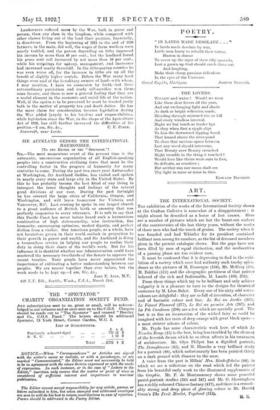ART.
THE INTERNATIONAL SOCIETY.
THE exhibition of the works of the International Society shown at the Grafton Galleries is somewhat of a disappointment : it might almost be described as a home of lost causes. Hero are a number of pictures which are but the burnt-out embers of the controversies of the last thirty years, without the works of those men who had the touch of genius. The society when it was founded and had Whistler for its president contained brilliant men among its numbers, as the list of deceased members given in the present catalogue shows. But the gaps have not been filled by men of equal distinction, and the mediocrities of a passing phase aro too evident now.
It must be confessed that it is depressing to find in the exhi- bition of a society which once had authority such trashy splen- dours as the pictures of M. Domergne (154), Mr. McEvoy (10), M. Boldini (111) and the oleographic prettiness of that painter beloved of the rich and fashionable, M. Laszlo (169, 201). -
From these things which try to be brilliant and only achieve vulgarity it is a pleasure to turn to the designs for theatrical costumes by M. Leon Bakst. Every one of his sixty odd water- colours are delightful : they are so full of invention, of character and of fantastic colour and lino. Le Roi an Jardin (265), Le Fiance Flamand (277), Le Roi an premier Acte (287), and La Fee Carabosse (298) are a few which are specially good. The last is as fine an incarnation of the wicked fairy as could be imagined with her train of deep orange with great black spots—. a most sinister scheme of colour.
Mr. Pryde has some characteristic work here, of which Le NUMer0 Rouge (15) is the best, being less troubled by the element of the feverish dream which he so often affects in his treatment of architecture. Mr. Glyn Philpot has a dignified portrait, The Draughtsman (85), and M. Blanche a very brilliant study for a portrait (88), which unfortunately has been painted thinly on a dark ground with disaster to the nose.
A voice from the past is Millais' Mrs. Bischoffsheint (86), in which we see a milestone on the road which led the painter from his beautiful early work to the illustrated supplements of the Graphic. Mr. F. de Montmorency shows some powerful pastel-portrait studies (345 and 347) and Mr. G. Sherringharn has a richly coloured Chinese fantasy (417), and there is a remark- ably strong and deep piece of glowing colour in Mr. Harold Owen's The Fruit Market, Togoland (213).
H. S.


































 Previous page
Previous page